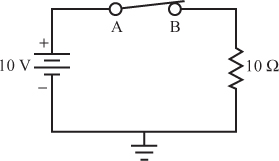Switches
31 A mechanical switch is a device that completes or breaks a circuit. The most familiar use is that of applying power to turn a device on or off. A switch can also permit a signal to pass from one place to another, prevent its passage, or route a signal to one of several places.
In this book, you work with two types of switches. The first is the simple on-off switch, also called a single pole single throw switch. The second is the single pole double throw switch. Figure 1.11 shows the circuit symbols for each.
Keep in mind the following two important facts about switches:
- A closed (or ON) switch has the total circuit current flowing through it. There is no voltage drop across its terminals.
- An open (or OFF) switch has no current flowing through it. The full circuit voltage appears between its terminals.
The circuit shown in Figure 1.12 includes a closed switch.

Get Complete Electronics Self-Teaching Guide with Projects now with the O’Reilly learning platform.
O’Reilly members experience books, live events, courses curated by job role, and more from O’Reilly and nearly 200 top publishers.



